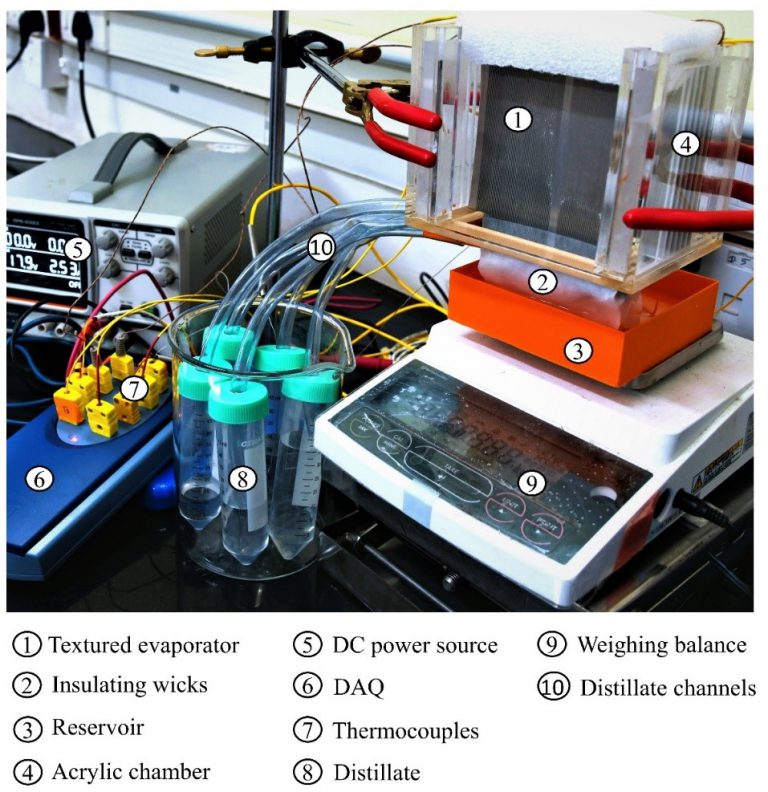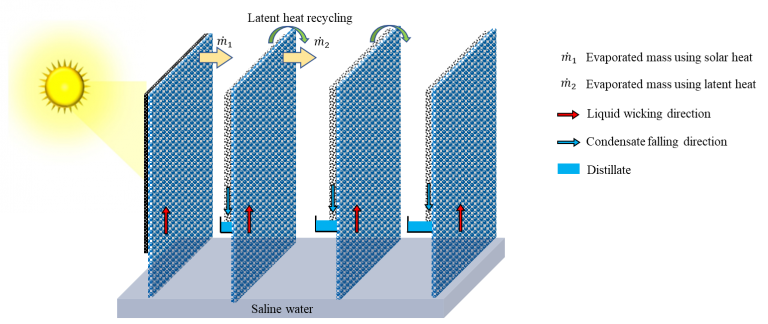
With summer temperatures soaring, the spectre of water scarcity looms large. As a possible solution to increase the availability of clean, potable water, researchers at IISc have developed a novel thermal desalination system which works using solar energy.
The most common methods for desalination are membrane-based reverse osmosis and thermal desalination. However, both consume a lot of energy.
Thermal desalination systems work by heating saltwater and then condensing the resulting vapour to obtain freshwater. But the energy required for evaporation is usually obtained from either electricity or the combustion of fossil fuels. An environmentally friendly alternative is using solar stills in which solar energy is employed to evaporate saltwater in large reservoirs, and the vapour that condenses on a transparent roof is collected. However, during condensation, a thin layer of water forms on the roof, reducing the amount of solar energy that can penetrate the reservoir and therefore the system’s efficiency.
As an alternative to such solar stills, the IISc team has developed a novel design for a solar-powered desalination unit that is more energy-efficient, cost-effective and portable, making it convenient to set up in areas with limited access to continuous electricity, explains Susmita Dash, Assistant Professor in the Department of Mechanical Engineering and corresponding author of the study published in Desalination.
The setup, designed by Dash and her PhD student Nabajit Deka, comprises a reservoir of saline water, an evaporator, and a condenser enclosed within an insulating chamber to avoid heat losses to the ambient air.

Their system works by using solar thermal energy to evaporate a small volume of water imbibed or “wicked” into the evaporator, which has a textured surface. The wicking of liquid into the evaporator takes advantage of the capillary effect of microscale textures. This effect allows liquids to be drawn into narrow spaces of a porous material, much like water being absorbed by a sponge. Utilising this approach, instead of heating the entire liquid volume in the reservoir, results in a significant improvement in the system’s energy efficiency, says Dash.
The team etched tiny grooves on the surface of the evaporator, which is made of aluminium. Deka explains that they had to experiment with different combinations of groove dimension and spacing as well as surface roughness to determine the right pattern for efficient wicking.
The condenser – often overlooked in a majority of desalination studies, according to the researchers – is another key element of the solar desalination system. To prevent the formation of the water film during condensation – like in the solar stills – Dash and Deka fabricated a condenser with alternating hydrophilic and superhydrophilic surfaces. The water droplets condensing on the hydrophilic patterns are pulled toward the superhydrophilic region. This affinity of the condensed water to the superhydrophilic region enables the hydrophilic surface to become free for a fresh batch of condensate, explains Dash.
During condensation, some heat gets lost to the atmosphere. The researchers designed the system in such a way that this heat released during condensation is also trapped and utilised to heat up the imbibed saltwater in a different evaporator at the backside of the condenser, which reduces the amount of solar energy needed, and increases the efficiency of the system even more. The team also successfully connected multiple evaporator-condenser combinations in a series, resulting in a multi-stage solar desalination system. This system, if built in a footprint area of 1 m2, has the capacity to produce one litre of potable water every 30 minutes – at least twice as much as that produced by a traditional solar still of the same size.
Apart from seawater, the system can also work with groundwater containing dissolved salts as well as brackish water. It can be adjusted to align with the shifting positions of the sun during the day.
The researchers are currently working on scaling up the system and improving its durability, and increasing the volume of drinking water produced, so that it can be deployed for domestic and commercial use.






